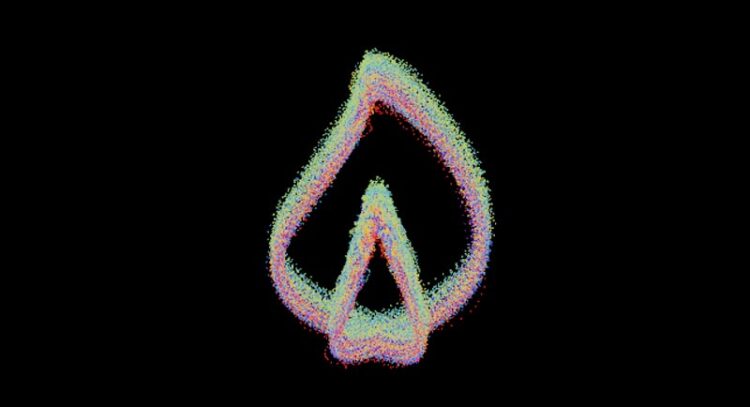Physicists Develop Highly Robust Time Crystal

What looks like a flame is the measurement of the new time crystal: Each point corresponds to an experimental value, resulting in different views of the periodic dynamics of the nuclear spin polarization of the time crystal.
© Alex Greilich/TU Dortmund
A team from TU Dortmund University recently succeeded in producing a highly durable time crystal that lived millions of times longer than could be shown in previous experiments. By doing so, they have corroborated an extremely interesting phenomenon that Nobel Prize laureate Frank Wilczek postulated around ten years ago and which had already found its way into science fiction movies. The results have now been published in Nature Physics.
Crystals or, to be more precise, crystals in space, are periodic arrangements of atoms over large length scales. This arrangement gives crystals their fascinating appearance, with smooth facets like in gemstones. As physics often treats space and time on one and the same level, for example in special relativity, Frank Wilczek, physicist at the Massachusetts Institute of Technology (MIT) and winner of the Nobel Prize in Physics, postulated in 2012 that, in addition to crystals in space, there must also be crystals in time. For this to be the case, he said, one of their physical properties would have to spontaneously begin to change periodically in time, even though the system does not experience corresponding periodic interference.

Dr. Alex Greilich Foto: TU Dortmund
That such time crystals could be possible was the subject of controversial scientific debate for several years – but quick to arrive in the movie theater: For example, a time crystal played a central role in Marvel Studios’ movie Avengers: Endgame (2019). From 2017 onwards, scientists have indeed succeeded on a handful of occasions in demonstrating a potential time crystal. However, these were systems that – unlike Wilczek’s original idea – are subjected to a temporal excitation with a specific periodicity, but then react with another period twice as long. A crystal that behaves periodically in time, although excitation is time-independent, i.e. constant, was only demonstrated in 2022 in a Bose-Einstein condensate. However, the crystal lived for just a few milliseconds.
Millions of times longer lifetime
The Dortmund physicists led by Dr. Alex Greilich have now designed a special crystal made of indium gallium arsenide, in which the nuclear spins act as a reservoir for the time crystal. The crystal is continuously illuminated so that a nuclear spin polarization forms through interaction with electron spins. And it is precisely this nuclear spin polarization that then spontaneously generates oscillations, equivalent to a time crystal. The status of the experiments at the present time is that the crystal’s lifetime is at least 40 minutes, which is ten million times longer than has been demonstrated to date, and it could potentially live far longer.
It is possible to vary the crystal’s period over wide ranges by systematically changing the experimental conditions. However, it is also possible to move into areas where the crystal “melts”, i.e. loses its periodicity. These areas are also interesting, as chaotic behavior, which can be maintained over long periods of time, is then manifested. This is the first time that scientists have been able to use theoretical tools to analyze the chaotic behavior of such systems.
Wissenschaftliche Ansprechpartner:
Dr. Alex Greilich
Department of Physics
alex.greilich@tu-dortmund.de
Originalpublikation:
All latest news from the category: Physics and Astronomy
This area deals with the fundamental laws and building blocks of nature and how they interact, the properties and the behavior of matter, and research into space and time and their structures.
innovations-report provides in-depth reports and articles on subjects such as astrophysics, laser technologies, nuclear, quantum, particle and solid-state physics, nanotechnologies, planetary research and findings (Mars, Venus) and developments related to the Hubble Telescope.
Newest articles

A ‘language’ for ML models to predict nanopore properties
A large number of 2D materials like graphene can have nanopores – small holes formed by missing atoms through which foreign substances can pass. The properties of these nanopores dictate many…

Clinically validated, wearable ultrasound patch
… for continuous blood pressure monitoring. A team of researchers at the University of California San Diego has developed a new and improved wearable ultrasound patch for continuous and noninvasive…

A new puzzle piece for string theory research
Dr. Ksenia Fedosova from the Cluster of Excellence Mathematics Münster, along with an international research team, has proven a conjecture in string theory that physicists had proposed regarding certain equations….



